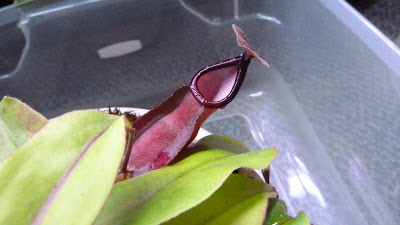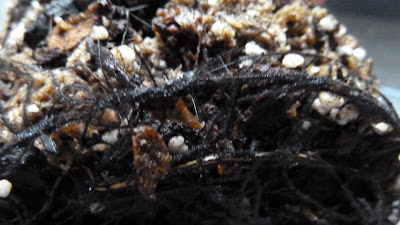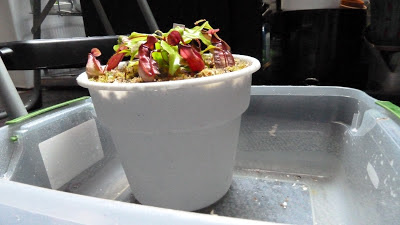I noticed this Nepenthes mirabilis var. globosa hadn't been growing any larger leaves, so I figured I'd re-pot it to check on the root system. Plus it's been about 2 years since it's last re-pot, and fast growing seedlings should at least be up-potted yearly so it's due.
I'll admit I've been ignoring this plant and I probably should've dealt with it's small growth earlier. The pitchers are nice, but not a good shape. Either the shape will change a lot before it matures, (it happens, this species can get a better or worse shape as they grow,) it's an ugly clone, or it was mislabeled and is a globosa hybrid. As of now, on the rating scale it would be a "grade C," due to the long neck the pitcher grows, ("Grade A's" have no neck and are a very round, highly sought after, shape called "Klom," the Thai word for circular/round.)
Below, this pitcher had formed in the top of another pitcher that had since died. Not relevant, just laughed when I saw it and decided to share.
This Nepenthes has always been filled with pitchers, it isn't unhappy, so on to figuring out what it's issue is by re-potting it 1st.
Funny, I hadn't seen the tag in some time. In cultivation this species has been called N. "Viking", N. globosa, N. "Trang Bizarre" and N. "sp. Phang-nga". As far as I can see, it's officially N. mirabilis var. globosa (M. Catal.) as of 2010. Personally, I like "Viking" the best, named for the shape the pitchers produce, see Neofarm's article on the topic for more information about the history of the plant itself.
So first things first. Pull the plant out of the pot. I'm in favor of holding the stem(s) firmly in one hand and with your other hand on the pot, dump the whole thing upside-down.
Holy roots! Yep, this one needed to be re-potted probably about a year ago. That black spiral is all root.
Next work out the old mix with your fingers. This is a re-pot, not an up-pot (more media/bigger pot) so all the old media has to go. There are roots throughout everything so this part takes a while if you do it carefully. The roots are fragile, so this took me about 1/2 hr. Last thing I wanted to do was set it back any further.
What's left is a few pieces of perlite and sphag that were stuck to the roots so I'll leave those be. The brown is the taproot, the thin black are feeder roots. You will break some of the feeder roots, it's guaranteed. A healthy Nepenthes will recover from some root loss quickly.
Now time to fill in the fresh media. Personally, for this one I used long fiber sphagnum moss, cedar bark, charcoal chunks, and perlite. Besides the Nepenthes that live in ultramafic soils, they like a mix that is free draining, stays moist, and is on the acidic side. The long fibered sphagnum accomplishes both the moisture and acidity requirements so I use it in the majority of my Nepenthes soil mixes, but everyone who grows these uses a different mix for different environments, (this is just what I've found works for me.)
Finished product: Ha! The pot looks ridiculously big for the size of the plant. Normally a re-pot looks appropriate for the size of the plant, but stunted growth on the top certainly didn't result in stunted growth below.
Back home:
Now seeing as how the taproot had grown to the bottom of the pot and started to wind around the bottom I'm hoping my lack of up-potting over the last year for this plant is what's been causing it's stunted leaf growth. Nepenthes aren't big fans of re-potting so they'll sulk for a week or two before starting to grow again. It'll probably be more like a few months before I can say for sure this was or wasn't the problem. Either way, I hope turning this post into more of a guide as well is helpful.














Awesome post Melody! Now I know how to repot my N. properly when I get one (soon! :)). Holy roots alright; that's an impressive root system going on down there, at least you know the roots are healthy. I don't know much about N. but it looks good to me; the pitchers look great & plentiful, although you're right, it prob. does appreciate the repot. Hope it solves the problem. That's weird about the pitcher growing on top of the old one huh? Kinda cool! :)
ReplyDeleteYay, Nepenthes will probably always be my favorite. Constant new pitchers on these feel like the equivalent of constant flowers on anything else.
DeleteA lot of the time the developing tendrils will seek out humid spots to lay the pitchers on, usually a neighboring pots soil here. What most likely happened was that there was still water in the older pitcher and when the new one grew, it thought it found a good spot until it couldn't inflate all the way and got stuck, lol.
If you pot yours up in mostly inorganic media, or a mix that doesn't break down easily, you don't have to go through the trouble of refreshing all of the media for 3-4 years at a time, (provided you use only rain, RO, or distilled water on them.) The sphagnum breaks down 1st in my mix, but even after 2 years it was still ok when I did this repot. If it wasn't for the fact that this plant was having an issue, I wouldn't have bothered refreshing all of it like I did. They really hate being disturbed. Nepenthes are happiest when left in one spot they can adjust to and then left alone.
Imagem linda, planta maravilhosa.
ReplyDeleteabraços
Thank you! :)
DeleteHi Melody,
ReplyDeleteAre pitchers the flowers of Nepenthes? Do they bear seeds?
thanks,
No the pitchers are an extension of the leaf. The plants do flower though, but either form male or female parts only, so won't self seed. You'd need both male and female flowering plants to create viable seed.
DeleteHi Melody,
ReplyDeleteMay I use you pictures of this Nepenthes?
Thank you.
rgds,
Yes! Anyone can use my pictures as long as they follow the Creative Commons Attribution-NonCommercial-NoDerivs licencing found at the top right of this page: http://creativecommons.org/licenses/by-nc-nd/3.0/
Delete